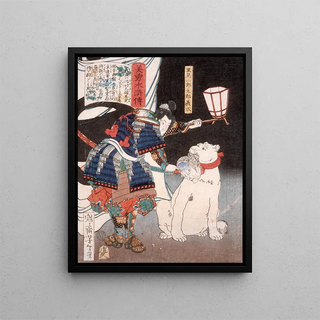Art print | Satomi Jirotarō Yoshinari inspecting a head carried by a dog - Tsukioka Yoshitoshi


View from behind

Frame (optional)
"Satomi Jirotarō Yoshinari inspecting a head carried by a dog" by Tsukioka Yoshitoshi sparks the imagination and immerses the viewer in a universe rich in symbolism and emotion. This iconic piece of ukiyo-e art, flourishing during the Edo period in Japan, transports us to a moment of contemplation where human and animal nature intersect. Through this art print, the gaze is immediately drawn to the depth of expressions and mastery of details. Every element of the composition tells a story, revealing layers of meaning that transcend mere visual representation.
Style and uniqueness of the work
The uniqueness of this art print lies in how Yoshitoshi blends tradition and innovation. Vibrant colors and flowing lines demonstrate exceptional craftsmanship, while the dynamic between the main character and the dog creates a poignant dialogue. The posture of Satomi Jirotarō Yoshinari, both thoughtful and determined, juxtaposes animal innocence with human complexity. Yoshitoshi, a true master of ukiyo-e, employs engraving techniques that bring textures to life, whether it’s the fur of the dog or Yoshinari’s traditional clothing. This art print is not just a simple depiction; it is an invitation to explore themes of loyalty, curiosity, and fatality—recurring motifs in Japanese art.
The artist and his influence
Tsukioka Yoshitoshi is recognized as one of the last great masters of ukiyo-e, an artistic style that prospered in Japan from the 17th to the 19th century. His work is marked by a unique sensitivity that combines realism and the fantastical, capturing the essence of his era while reinterpreting it through his own vision. Influenced by the social and political upheavals of his time, Yoshitoshi often incorporated historical and mythological narratives into his compositions, enriching the Japanese artistic heritage. His impact has endured beyond his period, inspiring many contemporary artists who see in him a pioneer of visual expression.

Matte finish

View from behind

Frame (optional)
"Satomi Jirotarō Yoshinari inspecting a head carried by a dog" by Tsukioka Yoshitoshi sparks the imagination and immerses the viewer in a universe rich in symbolism and emotion. This iconic piece of ukiyo-e art, flourishing during the Edo period in Japan, transports us to a moment of contemplation where human and animal nature intersect. Through this art print, the gaze is immediately drawn to the depth of expressions and mastery of details. Every element of the composition tells a story, revealing layers of meaning that transcend mere visual representation.
Style and uniqueness of the work
The uniqueness of this art print lies in how Yoshitoshi blends tradition and innovation. Vibrant colors and flowing lines demonstrate exceptional craftsmanship, while the dynamic between the main character and the dog creates a poignant dialogue. The posture of Satomi Jirotarō Yoshinari, both thoughtful and determined, juxtaposes animal innocence with human complexity. Yoshitoshi, a true master of ukiyo-e, employs engraving techniques that bring textures to life, whether it’s the fur of the dog or Yoshinari’s traditional clothing. This art print is not just a simple depiction; it is an invitation to explore themes of loyalty, curiosity, and fatality—recurring motifs in Japanese art.
The artist and his influence
Tsukioka Yoshitoshi is recognized as one of the last great masters of ukiyo-e, an artistic style that prospered in Japan from the 17th to the 19th century. His work is marked by a unique sensitivity that combines realism and the fantastical, capturing the essence of his era while reinterpreting it through his own vision. Influenced by the social and political upheavals of his time, Yoshitoshi often incorporated historical and mythological narratives into his compositions, enriching the Japanese artistic heritage. His impact has endured beyond his period, inspiring many contemporary artists who see in him a pioneer of visual expression.






